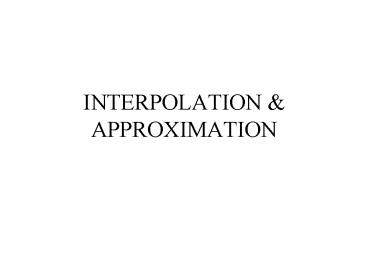INTERPOLATION - PowerPoint PPT Presentation
1 / 19
Title:
INTERPOLATION
Description:
Curve will pass near control points may interpolate the start and end points. Curve algorithm ... Interpolating curve : piecewise linear. Curve defined by ... – PowerPoint PPT presentation
Number of Views:43
Avg rating:3.0/5.0
Title: INTERPOLATION
1
INTERPOLATION APPROXIMATION
2
Curve algorithm
- General curve shape may be generated using method
of - Interpolation (also known as curve fitting)
- Curve will pass through control points
- Approximation
- Curve will pass near control points may
interpolate the start and end points.
3
Curve algorithm
interpolation
approximation
4
Interpolation vs approximation
curve must pass through control points
curve is influenced by control points
5
Parametric equation of line Vector equation of
a line
a
u
- P(t) a ut
- u (b-a)
- P(t) a (b-a)t
X(t) ax (bx ax)t Y(t) ay (by
ay)t Z(t) az (bz az )t
6
Linear interpolation
B
t1
A
t0
- P(t) A(1-t) Bt
- In matrix form
- P(t) A B . .
X(t) Y(t) Z(t)
-1 1 1 0
t 1
in animation - path , morphing
7
Interpolation Curves
- Curve is constrained to pass through all control
points - Given points P0, P1, ... Pn, find lowest degree
polynomial which passes through the points x(t)
an-1tn-1 .... a2t2 a1t a0 y(t)
bn-1tn-1 .... b2t2 b1t b0
8
Interpolating curve piecewise linear
- Curve defined by multiple segments (linear)
- Segments joints known as KNOTS
- Requires too many data points for most shape
- Representation not flexible enough to editing
9
Interpolating curve piecewise polynomial
- Segments defined by polynomial functions
- Segments join at KNOTS
- Most common polynomial used is cubic (3rd order)
- Segment shape controlled by two or more adjacent
control points.
10
Knot points
- Location where segments join referred to as knots
- Knots may or may not coincide with control points
in interpolating curves.
11
Curve continuity
- Concern is continuity at knots.
- Continuity conditions
- Point continuity (no slope or curvature
restriction / no gap) - Tangent continuity (same slope at knot)
- Curvature continuity ( same slope and curvature
at knot)
12
Curve continuity
- Continuity - Cn
- C0 continuity continuity of endpoint only or
continuity of position. - C1 continuity is tangent continuity or first
derivative of position - C2 continuity is curvature continuity or second
derivative of position.
13
Curve continuity
C0
C1
C2
14
Interpolation curves
- Typically possess curvature continuity
- Shape defined by
- Endpoint and control point location
- Tangent vectors at knots
- Curvature at knots
15
Interpolation vs. Approximation Curves
- Interpolation Curve over constrained ? lots of
(undesirable?) oscillations - Approximation Curve more reasonable?
16
Approximation techniques
- Developed to permit greater design flexibility in
the generation of free form curves - Common methods in modern CAD systems, bezier,
b-spline, NURBS - Employ control points (set of vertices that
approximate the curve)
17
Approximation techniques
- Curves do not pass directly through points
(except start and end) - Intermediate points affect shape as if exerting a
pull on the curve. - Allow user to set shape by pulling out curve
using control point location.
18
Example bezier curve
19
Cubic Bézier Curve
- 4 control points
- Curve passes through first last control point
- Curve is tangent at P1 to (P1-P2) and at P4 to
(P4-P3)































